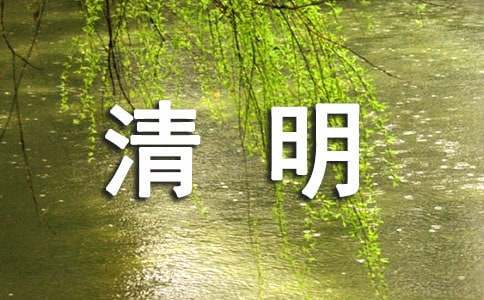- 相关推荐
清明节习俗双语版讲解
“清明”是中国传统二十四节气(the 24 traditional Chinese solar terms)中的第五个节气,也是诸多节气中唯一一个与传统节日“清明节”(Tomb Sweeping Day)重合的节气。下面是小编整理的清明节习俗双语版讲解,希望能够帮助到大家。

清明节习俗
第1篇:swing——荡秋千this is our country ancient qingmingfestival customs.
这是我国古代清明节习俗。
swing, meaning clench leather string and migration. itshistory is very old, and the first call century, in order to avoid after taboo,to swing. swing of the old tree yazhi multi-purpose for frame, then switch tomake the ribbons.
秋千,意即揪着皮绳而迁移。它的历史很古老,最早叫千秋,后为了避忌讳,改为秋千。古时的秋千多用树桠枝为架,再栓上彩带做成。
thengradually developed for use two rope and pedal swing.play not only improves the health swing, and can cultivate the brave spirit, tonow is people, especially childrens favorite.
后来逐步发展为用两根绳索加上踏板的秋千。打秋千不仅可以增进健康,而且可以培养勇敢精神,至今为人们特别是儿童所喜爱。
第2篇:gamecalled cuju——蹴鞠
a ball is bowed, ball with leather skinmade, the ball inside with wool plugged. a game called cuju, which is withenough to play football.
鞠是一种皮球,球皮用皮革做成,球内用毛塞紧。蹴鞠,就是用足去踢球。
this is ancient tomb-sweeping days favorite when a game.legend has it that the invention of the yellow emperor, original purpose isused to train warrior.
这是古代清明节时人们喜爱的一种游戏。相传是黄帝发明的,最初目的是用来训练武士。
第3篇:outing——踏青and that spring outing.
又叫春游。
that old tanchun,xunchun, etc. during march, spring warms the earth, nature become a vibrantpicture everywhere, it is the good old days for an outing.
古时叫探春、寻春等。三月清明,春回大地,自然界到处呈现一派生机勃勃的景象,正是郊游的大好时光。
our country folk tokeep for a long time the habit of clear outing.
我国民间长期保持着清明踏青的习惯。
清明节的美食
1.Green rice ball 青团
People in the Jiangnan region often eat this kind of green colored balls made from glutinous rice on Tomb Sweeping Day. Sincetheglutinousrice is mixed withbrome juice, therice balls aregreen.
江南地区的人们经常在清明节食用这种由糯米制成的绿色团子。由于糯米中混合雀麦草汁,所以团子呈绿色。
2.San zi 馓子
In the northand south ofChina, it is a tradition to eat san zi, or fried dough twist, on Tomb Sweeping Day. The differences between san zi made by Northern and Southern people lie in sizes and materials. The former one is larger, often made from wheat and the latter is finer and made from rice.
在中国,无论是北方还是南方,都有清明食用馓子(通过油炸面粉制成)的传统。差别在于北方馓子以麦面为主料,体积较大;而南方馓子则以米面为主料,更为精细。
3.Thin pancake 薄饼
People in Xiamen,Fujian province often have thin pancakes on Tomb Sweeping Day. Dried seaweed, omelette, veggies and chili sauce are added in the pancakes to enhance the flavor.
福建厦门的人在清明节时常常食用薄煎饼。人们把紫菜、煎蛋、蔬菜和辣椒酱加入薄饼中,会使薄饼更加美味。
4.Cudweed herb rolls 清明果
The best time to pick fresh cudweed herb is around Tomb Sweeping Day. The herb is often added in veggie rolls or dumplings and consumed on the day.
清明节前后,是采摘新鲜鼠曲草(清明草)的时机。当天,人们会在蔬菜卷或饺子里加入鼠曲草当作馅料。
5.Steamed rice with leaf mustard芥菜蒸米饭
In someplaces, people often steamed rice with leaf mustard on Tomb Sweeping Day to prevent scabies and other skin diseases.
在有些地方,人们经常在清明节时用芥菜蒸米饭,以预防疥疮等皮肤病。
6.Ai ban 艾粄
To Hakka people in China, ai ban, rice dumplings made from wormwood and rice, is a necessary dish on Tomb Sweeping Day. They blend wormwood paste and glutinous rice powder together and add sesame, peanuts and black-eyed beans. After steaming the dumplings for 15~20 minutes, the food is ready.
对于客家人来说,用艾草和糯米制成的艾粄是清明节必备的食物之一。将艾草汁和糯米粉混合在一起,加入芝麻、花生和眉豆,蒸上15到20分钟后,艾粄就做好了。
【清明节习俗双语版讲解】相关文章:
重阳节的习俗来历讲解介绍06-12
中秋节烧塔习俗的来历讲解03-19
清明节的习俗04-04
具有地方特色的中秋节习俗讲解06-17
清明节祭祖的习俗03-24
南昌清明节习俗08-08
北京的清明节习俗03-30
清明节习俗日记04-10
湖南清明节的习俗04-09
清明节习俗的简述03-21